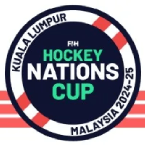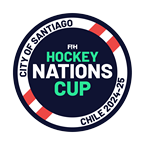
The International Hockey Federation (FIH) Executive Board has approved several changes to the rules of indoor hockey following a proposal from the Rules Committee. The majority of the changes are aimed at improving gameplay and the experience for spectators, while others are clarifications and tidying up of existing rules.
Most notably the number of times a team may substitute their goalkeepers off the pitch will now be limited to two per game, as opposed to the previous possibility for unlimited substitutions. The change addresses the issue of multiple goalkeeper substitutions during matches, which were detracting from the game and spectator experience. It also ensures that goalkeeping skills continue to be an integral part of the game, while still allowing teams to make tactical use of goalkeeper substitutions at suitable points during any game.
A limit on the maximum length of a hockey stick will be introduced into the rules for the first time, following the use of this requirement as a regulation at the Rabobank Hockey World Cup in The Hague last month. In recognition that goalkeepers were swapping to longer sticks for shoot-outs, which was considered as being against the spirit of the rules, all sticks must now be a maximum of 105cm long.
The breaking at a penalty corner regulation, which has been successfully used at FIH tournaments, is introduced as a full rule. An attacker who breaks into the circle early or any defender who crosses the back-line early is sent beyond the centre-line. Special provisions apply if a goalkeeper crosses the back-line early, with one of the other defenders being required to go beyond the centre-line. The use of this regulation has seen a dramatic decrease in the number of breaks, encouraging fair play and reducing the amount of time spent on re-setting penalty corners.
Leandro Negre, FIH President, said the rule changes would help drive the continued growth of the sport: “In all forms of the sport we strive to create the most fair, entertaining and competitive environment possible, with particular consideration for our increasingly global fan base. The changes introduced embody these values and are aimed at improving the game at all levels”
The complete list of rules changes can be found below.
Rule Changes to Indoor Hockey 2015
The following are the changes that were recommended by the FIH Rules Committee to, and approved by, the FIH Executive Board: -
i. Date of implementation: It was agreed that this should remain as 1 January 2015.
ii. Terminology
i. Hit – to be amended to ‘Striking or ‘slapping’ the ball …’ with the guidance from page 23 to be moved to this section
iii. Composition of team
i. Rule 2.3a – last paragraph of guidance to be changed from ‘If the goalkeeper or player with goalkeeping privileges is suspended, the offending team plays with one less player’ to ‘ … plays with one fewer player’
ii. Rule 2.3b – the change from 6 to 5 players has resulted in a tactical re-think on the part of a lot of Indoor Coaches, whereby their teams will try to attack with 5 field players and defend with 4 field players and a goalkeeper. This has resulted in multiple goalkeeper substitutions during matches, which has not been seen as an attractive aspect of Indoor Hockey.
In an effort to address this issue Rule 2.3f was adjusted, with effect from 25 November 2013, such that goalkeepers needed to be substituted (as all other players) within 3 metres of the centre-line. Whilst this has had some effect, it has not had the desired effect, and with agreement from the respective Continental Federations two trial goalkeeper substitution experiments were set up to operate at the PanAm Indoor Cups in Montevideo (URU) 7-12 April 2014 and at the Men’s Indoor Asia Cup in Changhua (TPE) 16-22 June 2014.
Following consideration of the feedback from the trials and a review of the information from the Rules questionnaires, the preferred route is a limitation of two fully kitted GK substitutions off the pitch per match (with allowances for injury and/or suspension) which would still permit teams to make tactical use of these at suitable points in any match.
Rule 2.3b currently reads: -
There is no limit to the number of players who are permitted to be substituted at the same time or to the number of times any player is permitted to substitute or be substituted
A Mandatory Experimental Rule 2.3b will read: -
There is no limit to the number of players who are permitted to be substituted at the same time or to the number of times any player is permitted to substitute or be substituted, except that the number of times a team may substitute their goalkeepers off the pitch is limited to a total of two per match
Guidance:
If a team has used their full allocation of goalkeeper substitutions and their goalkeeper is injured and incapable of continuing then, for safety reasons, that team is allowed if it so wishes one further substitution onto the pitch of another goalkeeper who is wearing full protective equipment. The substitution of this replacement goalkeeper should take place in accordance with Rule 2.3g and its guidance.
In the event that a goalkeeper receives a temporary suspension, their return to the pitch following its completion does not count towards the total number of goalkeeper substitutions, but only if they are replacing a player with goalkeeping privileges or another field player. Should they return to the pitch in place of another goalkeeper who is wearing full protective equipment, this will count towards the total number of times a team may substitute off their goalkeepers.
If a team has used their full allocation of goalkeeper substitutions and their goalkeeper receives a temporary or permanent suspension then, for safety reasons, that team is allowed if it so wishes one further substitution onto the pitch of another goalkeeper who is wearing full protective equipment. The substitution of this replacement goalkeeper should take place in accordance with Rule 2.3g and its guidance.
iii. Rule 2.3d – the guidance to be adjusted from ‘one less player’ to ‘one fewer player’
iv. Conduct of play: players
i. Rule 9.5 – the guidance regarding ‘slap’ hitting is to be deleted and inserted in the terminology section.
ii. Rule 9.11 - Guidance to be adjusted from ‘The player only commits an offence if they voluntarily use their hand, foot or body to play the ball …’ to ‘The player only commits an offence if they gain an advantage …’
iii. Rule 9.19 – greater emphasis to be placed in the guidance on intentional, as compared to unintentional, trapping of the ball against the boards.
v. Penalties
i. Rule 12.1 - Guidance that ‘If awarding a penalty is not an advantage to the team which did not break the Rules play must continue’ to be deleted, since it does not add anything to the Rule
ii. Rule 12.4c – given that the Regulation concerning Breaking the line at Penalty Corners will be adopted as a Rule, the requirement that a penalty stroke is awarded ‘for defenders persistently crossing the back-line before permitted during the taking of penalty corners’ will be deleted. Breaking at Penalty Corners can now be managed using the new Rule, noting that the penalty stroke provision was only very rarely invoked
iii. Rule 12.5 – the provision, if there is another offence or misconduct before the awarded penalty has been taken, to progress a free push by up to 5 metres is to be deleted. This has become redundant with the new Free Push Rules and the ability to self-pass, whilst any other offence or misconduct can be managed using the other provisions in Rules 12.5b, c and d, and/or Rule 14 Personal penalties.
vi. Procedure for taking penalties
i. Rule 13.3h – this Rule that ‘until the ball has been played, no attacker other than the one taking the push from the back-line is permitted to enter the circle and no defender is permitted to cross the centre-line or back-line’ is to be supplemented by the adoption of the Breaking at a Penalty Corner Regulation as a Rule
ii. Rules 13.7b, 13.7c & 13.7d – to be adjusted by the adoption of the Breaking at a Penalty Corner Regulation as a Rule
iii. Rule 13.10d - the guidance that ‘if the player defending the stroke prevents a goal being scored but moves either foot before the ball has been played, this player must be warned (green card) and for any subsequent offence must be suspended (yellow card)’ to be amended to ‘if the player defending the stroke prevents a goal being scored but moves either foot before the ball has been played, this player may be awarded a personal penalty and for any subsequent offence must be suspended’.
vii. Personal penalties
i. Rule 14.1b – it was decided not to adopt the Regulation that a green card indicates a temporary suspension of one minute as a Rule, since it was considered that the green card as a warning is still important at lower levels of the game. It will however remain as an FIH Tournament Regulation
ii. Rules 14.1c and 14.1d – the guidance to be adjusted from ‘… one less player’ to ‘… one fewer player’.
viii. Umpiring signals
i. 4.6c Penalties – as a result of the deletion of Rule 12.5a and advancing a Free Push up to 5 metres, it follows that the signal should also be deleted
ix. Field and Equipment Specifications
i. 2.18 Stick – in view of longer than normal sticks being used by goalkeepers at Shoot-out competitions, the stick specification will now include a maximum length provision, ‘the length of stick, as measured from the top of the stick to the bottom of the head of the stick (line X in Figure 3 on page 57 of the Rules of Indoor Hockey), shall not be more than 105cm’

























